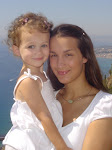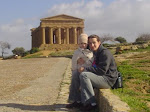Given the time and resources necessary to travel anywhere in the world to undertake an ethnographic research project would take me back to Sicily. Although I lived in Sicily for three years, after learning about ethnography and folklore, I feel I missed a lot of Sicily’s history that is not necessarily told by a tour guide or written in a book. The area of interest to study would be the folklore behind the mafia, which holds great power on the island and over the Sicilians. Although the folklore surrounding the mafia would be interesting, I do not think it wise to explore. So with that said, I would focus my ethnographic research on the folklore of Mt Etna.
Mt Etna is Europe’s largest, active volcano. When first moving to Sicily, my family and I rented a villa located in Nicolosi, often called the Gateway to Etna, because of its location on the base slopes of the mountain. Upon moving into the villa we did our research on the internet and asked many questions on the possibility of an eruption during our stay, the answers were of no worries. We took many drives up the mountain to enjoy the view and to also see the ruins of the past eruptions. As crazy as it may sound when saying it and I am sure reading it, we thought it exciting to see and to live on the slopes of an active volcano.
After reading chapter seven I realized there were many accounts of folklore right in front of my eyes and ears but I was unaware of what I would want to know in the future. Now, I feel I missed an opportunity to gather information to suffice my curiosity and questions of today. Thinking back on my time in Sicily, at times I feel I was simply a tourist living in another country for three years and did not take advantage of the time I had there. Don’t get me wrong, I traveled, took many great pictures, saw and did many things I otherwise would not have had the chance to do. But by the questions I have now, I feel I did not ask as many questions while I was there, or immerse myself into the culture as I should have.
If given the opportunity to undertake an ethnographic research project, I feel I now have the proper tools to embark upon a journey of gathering much desired information. Chapter seven states the basic steps and process of fieldwork which would serve as a guideline while in the field. Within the basic steps page 206 lists the tools, aside from ones “natural tools”, needed to aide in attainment of information. Aside from the great tool list, the chapter also emphasizes on developing good questions to ask and how to properly listen.
After missing the opportunity of immersing myself, ethnographically speaking, while in Sicily, I have thought of the ways in which I would go about accomplishing my fieldwork. First, I would become fluent in the local language, not learn just enough to get by, my first mistake. I think language is the key barrier in learning local costumes and ways of living. I managed to get along quite well without being fluent in Sicilian or Italian, but know I missed out on a lot. Also, I would interview, with my tools, the locals living in Nicolosi and also the people who live, refusing to leave, further up the mountain. There is also a site located, as far as a car is able to drive, atop the mountain where my family and I would go to have hot chocolate and buy Mt Etna memorabilia in the small cabins situated there for tourists. There, the people of the shops and serving hot chocolate would surely have a few stories to share. Also the larger city of Catania, which has been the brunt of eruptions, would be an ideal area to gather information. I would interview the older community as well as the younger, and compare the folklore that has been passed on throughout the years.
Completing this ethnographic research would be worth doing, because I feel it would be self fulfilling. This project would allow me to answer the many questions of who, what, when, where and how that I have now invoked throughout my learning of ethnography, fieldwork and folklore.
“This blog entry is my response to the chapter seven reflection
question.”
Sims, Martha C., and Martine Stephens. Living Folklore An Introduction to the Study of People and Their Traditions. Logan, Utah: Utah State University Press, 2005.
Sunday, December 9, 2007
Sunday, December 2, 2007
"Bloody Mary" (Chapter Six Reflection)
After reading chapter six, I found psychoanalytic interpretation to be the most compelling interpretive approach to folklore. I have studied Bruno Bettelheim and find his work to have a significant association between psychoanalysis and it’s relation to “symbolic metaphors for puberty, sexual maturity, seduction and death” no matter how strange the correlations are they seem to exist (189). Knowing this information about Bruno Bettelheim allowed me to better understand Alan Dundes.
Alan Dundes “continues to work to illustrate the value of this approach through his own analysis of texts as well as through outright arguments about the power of this kind of interpretation” (188). Dundes completed essays on the psychoanalytic interpretations of folklore including “the ritual calling of “Bloody Mary” (188). Quite familiar with Bloody Mary, I was surprised to read Dundes interpretation of the ritual. Not once when I was a young girl performing this ritual in the bathroom of my cousin’s house did I ever relate it to my first menses, nor did my sister or cousin who also played the game. We thought of Bloody Mary as simply a scary game to play. We would pile in the bathroom, turn off the lights, decide who said “Bloody Mary” three times, turn in circles three times, turn on the flashlight, look in the mirror and run out screaming. That was our game.
After reading Dundes interpretation and the psychoanalytical parallel, I now see why and how he could come to his conclusion. He provides reasons to back up his interpretations: context, language, and images (188-189). The context serves as an “anticipatory ritual, average American girl’s menarche is twelve and a half, the girls performing the ritual are usually between the ages of seven and twelve” (189). The language in the ritual, reciting the name “Bloody Mary” implies the connection to the “Virgin Mary, and the risk of pregnancy” (189). Also, the word “Bloody” signifies the relation to menstruation. The last of the reasoning is images. The reflection in the mirror that one is supposed to see is an image of a woman with blood on her face, this relates to self-image (189).
The psychoanalytic interpretation of Alan Dundes has allowed me to look closer at the ritual/game I once played as a young girl. I never thought of “Bloody Mary” in the relation to menstruation or as an anticipatory ritual upon attaining puberty. Also not to forget, this ritual is performed in the bathroom. As bizarre as the connection may seem, the interpretation is apparent through Dundes research. Never again will I think of Bloody Mary as just a scary children’s game.
“This blog entry is my response to the chapter six reflection question.”
Sims, Martha C., and Martine Stephens. Living Folklore An Introduction to the Study of People and Their Traditions. Logan, Utah: Utah State University Press, 2005.
Alan Dundes “continues to work to illustrate the value of this approach through his own analysis of texts as well as through outright arguments about the power of this kind of interpretation” (188). Dundes completed essays on the psychoanalytic interpretations of folklore including “the ritual calling of “Bloody Mary” (188). Quite familiar with Bloody Mary, I was surprised to read Dundes interpretation of the ritual. Not once when I was a young girl performing this ritual in the bathroom of my cousin’s house did I ever relate it to my first menses, nor did my sister or cousin who also played the game. We thought of Bloody Mary as simply a scary game to play. We would pile in the bathroom, turn off the lights, decide who said “Bloody Mary” three times, turn in circles three times, turn on the flashlight, look in the mirror and run out screaming. That was our game.
After reading Dundes interpretation and the psychoanalytical parallel, I now see why and how he could come to his conclusion. He provides reasons to back up his interpretations: context, language, and images (188-189). The context serves as an “anticipatory ritual, average American girl’s menarche is twelve and a half, the girls performing the ritual are usually between the ages of seven and twelve” (189). The language in the ritual, reciting the name “Bloody Mary” implies the connection to the “Virgin Mary, and the risk of pregnancy” (189). Also, the word “Bloody” signifies the relation to menstruation. The last of the reasoning is images. The reflection in the mirror that one is supposed to see is an image of a woman with blood on her face, this relates to self-image (189).
The psychoanalytic interpretation of Alan Dundes has allowed me to look closer at the ritual/game I once played as a young girl. I never thought of “Bloody Mary” in the relation to menstruation or as an anticipatory ritual upon attaining puberty. Also not to forget, this ritual is performed in the bathroom. As bizarre as the connection may seem, the interpretation is apparent through Dundes research. Never again will I think of Bloody Mary as just a scary children’s game.
“This blog entry is my response to the chapter six reflection question.”
Sims, Martha C., and Martine Stephens. Living Folklore An Introduction to the Study of People and Their Traditions. Logan, Utah: Utah State University Press, 2005.
Subscribe to:
Posts (Atom)







